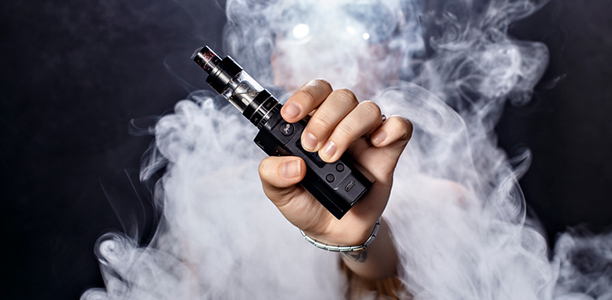They’ve been hailed as the danger-free alternative to nicotine-based cigarettes. But are electronic cigarettes really safer? The short answer: no.
“The big ‘wow’ moment for us was finding out that even the nicotine-free e-cigarettes should not be encouraged during pregnancy,” says Senior Lecturer in the School of Life Sciences Hui Chen.
“It’s often challenging for us to convince people about the necessity of our research as people already know cigarettes are harmful.” But this research, she explains, “Makes people question the safety of e-cigarettes. Some people believe that nicotine is the only harmful ingredient in e-cigarettes, but when we studied the ‘nicotine-free’ e-cigarettes, we found similar outcomes to those with nicotine and sometimes were even worse.”
Hui says, when it comes to e-cigarettes, “It’s really what happens to the fluids when they are vaporised that makes them bad.”
Associate Professor in the School of Life Sciences Brian Oliver adds, “The difficulty with e-cigarettes is the terminology that is used. There is ‘safer than cigarettes’ and then there is ‘safe’ in its own right.
“It’s like if you eat something that is ‘half the fat’ then that is bound to be better than something that is ‘full fat’ but if you overindulge in it you will still get the same negative health conditions.”
Hui and Brian are part of the Medical Science discipline group, which also includes Chancellor’s Postdoctoral Research Fellows Pawan Sharma and David Chapman. Together, they’ve published the world’s first paper on the effects of e-cigarettes during pregnancy on the offspring’s lung health outcomes.
Brian credits much of the decision to study e-cigarettes to David. “I was a bit reluctant at first as I thought e-cigarettes were a bit of a fad, however, David saw what was going on and looked at our skill sets and thought it would be a great opportunity.”
The reality, agree Hui and Brian, is the popularity and use of e-cigarettes is rising worldwide. And even though Australia has banned the use of nicotine-based e-cigarettes, nicotine-free e-vaping is still legal.
But that doesn’t mean it’s safe. In fact, the team’s research proved e-cigarettes, even those that didn’t contain nicotine, caused a wide range of health problems in both mothers and offspring.
The effects included, but were not limited to, difficulty conceiving as well as inflammation of the lung in the mother and child. They say the exposure to toxins present in the e-cigarettes create epigenetic changes whereby the conditions become hereditary and lasting.
Another similarity that was found between smoking cigarettes and e-cigarettes was that they both cause oxidative damage to the airways.
“Once seeing these negative results, we started to look for ways to reverse the effects,” says Hui, who credited the choice of antioxidants to her long-term collaborator Sonia Saad at the Kolling Institute of Medical Research. “Something interesting we found was that if mothers take extra antioxidants while exposed to the cigarette smoke, it can help in minimising the effects.”
However, with over 7000 flavours of e-cigarette fluid being manufactured worldwide, each flavour comes with its own set of risks.
Brian explains: “In the UK, where e-cigarettes are actually encouraged by the government as an alternative to cigarettes, there are still two flavours which have been banned – butterscotch and menthol.”
The toxins within the butterscotch flavour were similar to those used in microwave popcorn, which caused workers in popcorn plants to contract bronchiolitis obliterans, or ‘popcorn lung’, which causes inflammation and scarring in the airways.
Brian says, “The fluids which contain the flavours can be made in someone’s garage or in a factory, we just don’t know. And as scientists, if we don’t stand up and say ‘no, this may be bad’, then we are not doing our job.”
Hui, who grew up in China where smoking is not just a habit but also a social activity, has always been curious about the effects of smoking and the implications for foetuses.
“I started studying maternal smoking in 2006 and Brian and I began working together on e-cigarettes in 2015, which has been a very fruitful and successful collaboration,” she says.
Despite Australia having one of the lowest smoking rates worldwide, our national numbers show that 15 per cent of Australian women smoke during pregnancy. Many also turn to e-cigarettes as they believe them to be the safer option.
However, nicotine is a registered poison and there are strict regulations surrounding cigarettes.
“We all know cigarettes are bad but they’re easily regulated so there is not really one cigarette that is worse than another one, but with e-cigarettes there is such a large unregulated quantity that it leads to no end of problems,” says Brian.
Since the team’s paper was published late last year, Brian has had the opportunity to speak to the ABC alongside the NSW Minister of Health and Minister for Medical Research Brad Hazzard about the risks of e-cigarettes.
He hopes the research will further strengthen the Australian Government’s ban on nicotine e-cigarettes and create stricter guidelines surrounding the non-nicotine ones.
Hui, a mother herself, agrees. “Even though we won’t see a complete picture of the effects of e-cigarettes until 2050 to 2060, we hope we can still influence the policy now.
“Pregnant mothers, in particular, need to be informed as they are creating our future generations.”
(Source: UTS)










